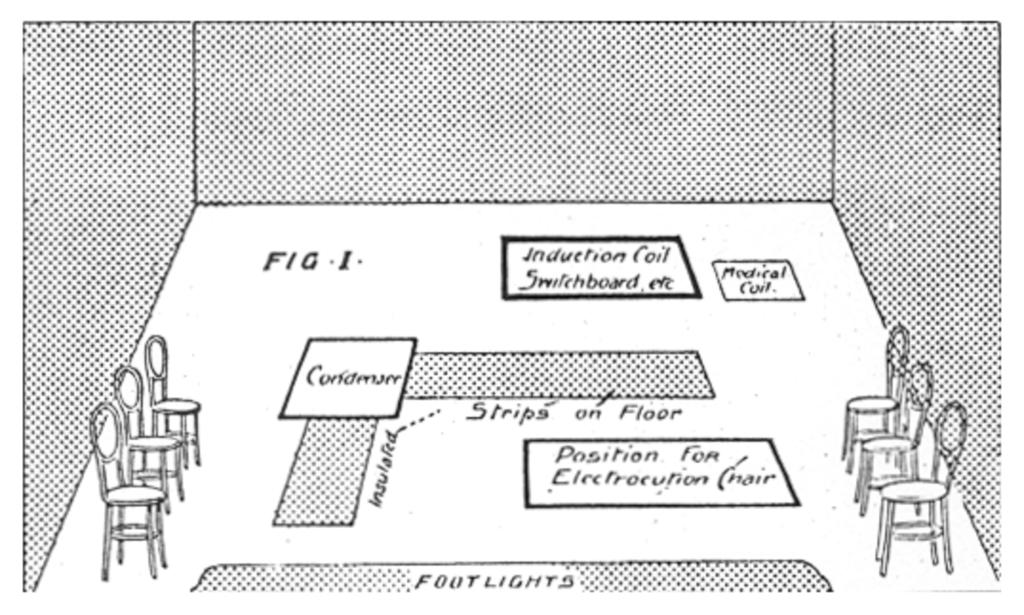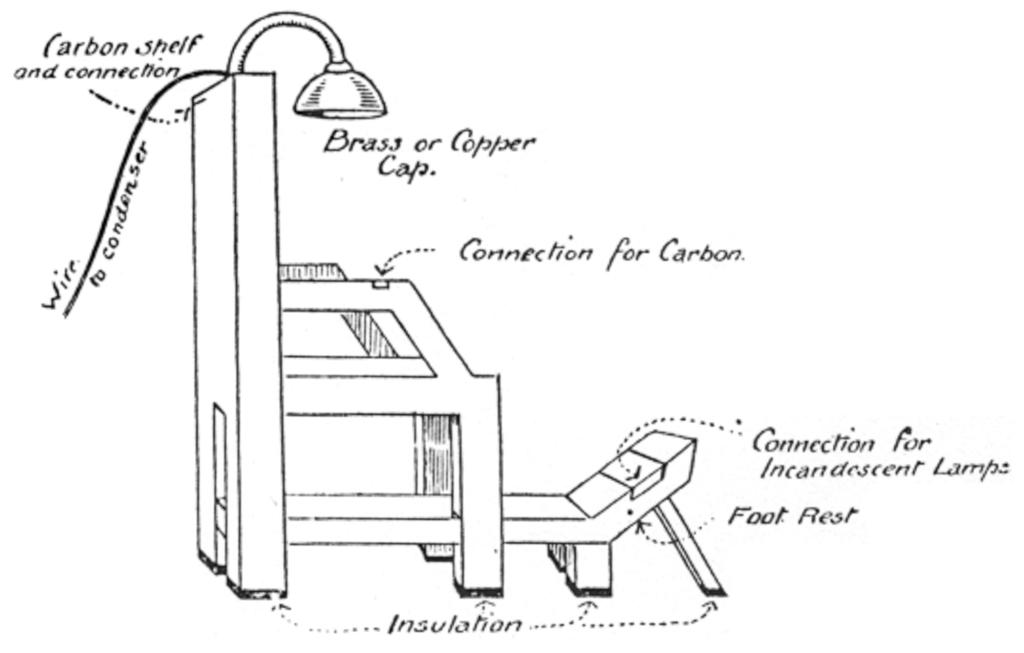TCBA Volume 7 - Issue 1
Page 12 of 18
Stage Electricity.
Description of the Apparatus.
The electrical apparatus required to give an exhibition of a most startling nature on the stage is as follows: -
The principal part consists of an induction coil of large size in order to give a long spark, as the longer the spark the more effective the experiments. A coil giving a twelve inch spark is very suitable for stage purposes
A Wimshurst or other friction machine can be used in place of the coil, but not with as great effect, as the machine has to be kept continually rotated, and the atmospheric conditions greatly affect the reliability of the machines, whereas a coil will work under almost any condition whatever.
The necessary apparatus can be purchased at Messrs. A. W. Gamage, Ltd., Holborn, London.
In addition to the coil, a pair of Henley dischargers will be required, and also a large sized condenser of the Leyden jar, or any other style, according to the taste of each particular performer.
The sparking arrangement is set up between the coil and the condenser, being connected to the coil in the usual manner for charging, explained in a future number of “The Magician.”
As space in this book is limited, it will be necessary for the. reader to study one or two works on “Static Electricity,” in order to become familiar with the general principles of same, and then adapt the principles to the instructions herein.
Two useful books to obtain are, The Model Engineer series, No. 15 and 18; they are entitled, “Simple Experiments in Static Electricity,” and “Simple Scientific Experiments.” Both books are published by the “Model Engineer” Co., and obtainable at Gamages, Ltd. The arrangement of the apparatus on the stage is as follows: -
The coil should be placed on a table at the back of the stage to the left of the performer. The sparking arrangement is set a little to the right of the table, or it may be arranged on the lower part of the insulated stand on which you place the condenser.
If the condenser and the spark dischargers are on separate stands, place the dischargers a little to left of the condenser in order that the audience may get a full view of the spark.
To charge the condenser or Leyden jar, connect one of the secondary terminals of the coil to the outer coating of the condenser and connect the inner coating to one of the arms of the Henley discharger, the other arm being attached to the remaining secondary terminal of the coil.
Now set the coil working when the jar or condenser will be charged with static electricity.
As the jar becomes charged, as much electricity runs away from the outer coating as there is electricity collecting on the inner coating; if a person touch the outside of the condenser, the escaping electricity will pass through him to the earth; if the fingers do not actually touch the coating of the condenser, the electricity will jump as it were across the space between the condenser and the fingers in the form of sparks. The larger the coil used for charging, the more vivid and larger will the spark be. The sparks flow across in rapid succession, appearing to the onlooker as a kind of flame.
The coil can be worked from accumulators or from the town supply if the current is reduced to the required voltage. The voltage should be two volts to every half-inch of spark; that is, if you are using a twelve inch spark coil forty-eight volts will be required to work it.
The stage will have to be partly insulated by having a carpet of non-insulating material put down, under which is placed strips of gutta-percha or other insulating material, each strip to be about twelve inches in width - one strip to be put from the condenser down towards the foot-lights, this strip to be about three feet long, another strip about four feet long to be placed from the condenser towards the table to the left of the stage. The carpet must be marked that the performer may know exactly where the strips are placed, and the stage is insulated. (See Fig. 1.)
A piece of apparatus known as the electrocution chair is also required. The chair is made of heavy wood to appear massive. The legs are insulated where they touch the floor. A footboard is placed about six inches from the floor, on which the subject rests her feet. (The subject can be either a lady or a gentleman, but for our purpose we will presume the subject to be of the gentler sex). Fastened to a curved arm at the head of the chair is a brass or copper cap from which a wire runs to the outer coating of the condenser. (See Fig. 2). The subject for the chair experiment is brought on to the stage by the performer barefooted, put into the chair, the brass cap adjusted to fit on the head.
The performer then pretends to hypnotize her. Previous to doing this, a short lecture is given on the cruelty of electrocution as practised in America. The subject on the chair is supposed to have passed through the body thousands of volts of electricity (which she does have passed, but of “static,” not current electricity), enough to kill her if not under hypnotic influence, so the performer states.
The coil is then started, the current passes through the condenser and thence by the wire and the cap to the subject in the chair, who owing to being insulated does not receive into her body any electricity until touched by someone or something that is connected to the earth. Anything connected with the earth electrically is termed uninsulated, as the earth being a conductor draws the electricity away from wherever it is stored; for instance, the performer standing on the strip of gutta-percha under the carpet is thus insulated, if he now touches the subject in the chair there is no sign of electricity, but let the performer put one foot on the uninsulated portion of the stage, the electricity will then be seen to pass from the subject in the chair to the performer. If the hand does not quite touch the body of the subject, the electricity will jump across the space in the shape of vivid sparks, the size and beauty of the sparks varying according to the amount of electricity that comes from the condenser.


